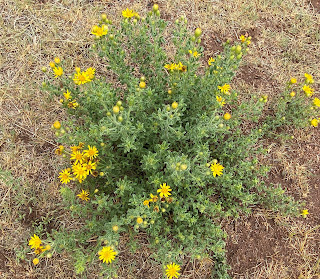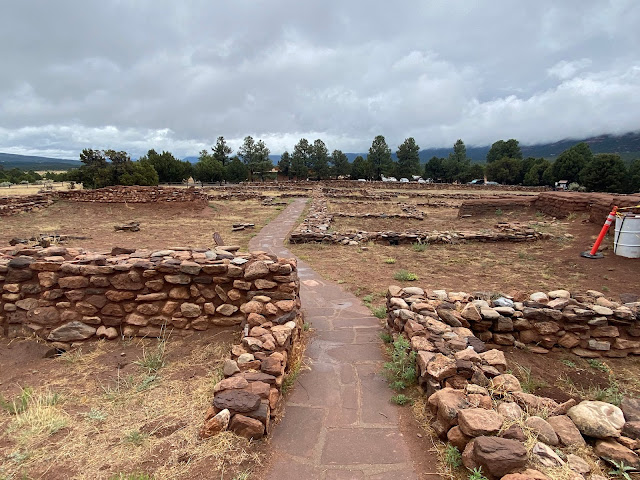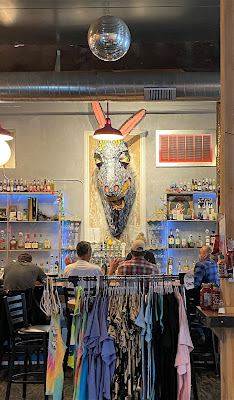June 29, 2021
The one food I really wanted to eat in New Mexico was a Navajo taco. I remembered eating one on a visit to New Mexico 30 years earlier, and I remembered how amazing it was.
A Yelp search for Navajo tacos led us to Los Amigos in Santa Fe. We ordered two for take out (for a whopping $27!) and ate them in the car. I was so disappointed. They were just American-style tostadas on a piece of not-that-great fry bread. They were also huge and so loaded that we couldn't get to the bottom. We ended up eating about half and tossing the rest. I would have been happier with the giant Coke we saw at the side of the road as we left town.
On our way to Pecos National Historic Park, we passed this mural. I was intrigued enough to take a photo. Turns out it is a painting of Pecos Park itself!
The national park includes thousands of acres, but the main section contains the ruins of Pecos Pueblo, also known as Cicuye, "the village of 500 warriors." The pueblo's first buildings were built around AD 1100, and by about 1450, there were more than 2,000 people living on the site in a five-story building. According to Baltazar de Obregón, Pecos Pueblo "is congregated on a high and narrow hill. . . . It has the greatest and best buildings of these provinces and is most thickly settled. . . . It is enclosed and protected by a wall . . . and by tiers of walkways which look out on the countryside."
The Pecos people were farmers, and the broad valley we saw looks perfect for cultivated crops of the Three Sisters: bans, corn, and squash. The pueblo was strategically located and a major center of trade.
The base of the wall still snakes around what must have been the perimeter of the living quarters.
The remains of over twenty ceremonial underground kivas still remain, with some restored so that visitors can go inside.
I climbed down the ladder and Bob stayed up top.
I would say the kiva was about 10 feet deep. Some of the kivas in the park have diameters as wide as 40 feet. This one could have been that large.
Other kivas were not as deep, or perhaps are not fully excavated.
Some caution signs are more effective than others. Just sayin'.
In the stillness, I could almost imagine this scene from five or six hundred years ago.
Flowering plants added a rainbow of color.
I recognized this plant--a kind of wild squash that grows in the canyon near our house.
Pecos National Historic Park is known not just for the Pecos Pueblo ruins, but for what is left of the Mission Nuestra Señora de los Ángeles de Porciúncula de los Pecos, a church built by the Spaniards in 1619. Located on the highpoint of the area, it can be seen from all over the park.
While not a lot of it is left . . .
. . . signage helps visitors imagine what the huge adobe church would have looked like in its heyday.
Other signage near the ruins notes, "After years of oppression, and epidemics and droughts that killed many, the people of Pecos rebelled against Spanish authority in 1680." Uniting with other pueblos in the region, they drove the Spaniards out of New Mexico and destroyed the church, the symbol of the Spaniards' power. Their independence, however, was short-lived. Twelve years later, the Spaniards returned, and they rebuilt a smaller version of the church on this spot in 1717. Sadly, the population began a steady decline due to disease, famine, and raids, and in 1838, the few who remained abandoned this site.
More walls from the original pueblo are being restored around the church ruins. I think those circles of rocks in the picture on the right mark the openings to underground kivas.
During this part of the trip, Bob and I were listening to a book called Appetite for America that is about an entrepreneur named Fred Harvey who partnered with the Santa Fe Railroad to bring tourism to the Wild West. One of the things he did was provide tours that left from train depots and took guests to Indian villages, then returned them to the station to catch the next train. One of those tours came to Pecos National Historic Park. The two photos below are from signage at Pecos Park.
Note the church ruins, top left.
All that walking made us hungry. Bob had scouted out the Giant Skillet for our dinner. It was quirky rather than classy, at least as far as the décor was concerned.
I was still full from the massive Navajo taco we'd had for lunch, so I shared Bob's order of elote fries (fries topped with roasted corn coated in queso, sour cream, feta, spicy mayo, and chile flakes), which were absolutely divine. I would go back for those. He also ordered sautéed brussels sprouts, which were okay . . .
. . . and this enormous Three Sisters Burrito (corn, beans, and squash, with green chile, rice, lettuce, cheese, sour cream, and pico). One bite was enough for me, but Bob liked it.
There was interesting décor outside as well as inside.
The weather was getting sloppy, but we had two more places we wanted to go while we still had light. The first was the United World College in Montezuma, New Mexico. It is also known as the Armand Hammer United World College of the American West. (It was founded in 1982 by industrialist and philanthropist Armand Hammer.) The school is part of a global network of 18 schools on 4 continents that operate on the International Baccaulareate system, a two-year program for 16 to 19 year olds.
We were less interested in the school, however, than we were in one of its buildings, a 90,000-square-foot brick structure once known as "Montezuma's Castle." It was constructed in 1886 by the Atchison, Topeka & Santa Fe Railroad as a luxury hotel with 400 rooms. In its early years, the hotel was run by Fred Harvey, the man mentioned above who provided tourist opportunities in connection with the Santa Fe Railroad.
Unfortunately, the campus was completely closed to visitors because of the Covid-19 pandemic, so we could not go inside the castle.
Our next stop was another Harvey-operated property, the Casteneda Hotel in Las Vegas (New Mexico, not Nevada). This hotel opened in 1898 and closed in 1948. It was also built by the Atchison, Topeka and Santa Fe Railway.
At 30,000 square feet, it is only a third the size of the Montezuma Castle, but after years of disuse, it was restored and since 2019 has been functioning as a hotel once more. When we were there, a movie company had the entire thing booked for its crew, so we were not allowed past the lobby.
One of the fun things about the Casteneda is that is located right next to the Las Vegas railroad station. I can picture the train stopping here and dozens of disembarking passengers going straight to their hotel just a short walk away.
The first reunion of Teddy Roosevelt's Rough Riders was hosted here in 1899.
To me, it smelled a bit like decayed elegance and a hint of mothballs, but it was fun to imagine it in its prime.
READING
As mentioned above, as we drove around New Mexico, Bob and I were listening to Appetite for America by Stephen Fried, the biography of Fred Harvey, an English immigrant who started out as a pot scrubber in a New York City restaurant and made a fortune as a innovator in the travel and tourism industry. During the last quarter of the 19th century, he partnered with railroads to create high quality dining cars, restaurants, souvenir shops, hotels, and side tours for travelers. He created the hospitality industry that we take for granted today and is said to have created the first restaurant chain--Fred Harvey's. He also changed the working scene for women by hiring single women between the ages of 18 to 30 to work in his upscale train dining cars and restaurants. Known as "Harvey Girls," these women blazed the way for more young women to "go to work" in acceptable, responsible positions.
MOVIE
Another version of the Fred Harvey story is The Harvey Girls, a 1946 musical starring Judy Garland, Angela Lansbury, Cyd Charisse, and Ray Bolger. Judy Garland plays a young woman on a train headed west to become a mail order bride, but along the way she makes friend with a group of Harvey Girls headed west to open a new Harvey House Restaurant and becomes one of them. *Spoiler Alert!* She ends up marrying a different man than the one she traveled out to marry. The story was a little cheesy, but I enjoyed seeing Judy Garland with her Wizard of Oz co-star (Ray Bolger, the Scarecrow). The big production number, "On the Atchison, Topeka and the Santa Fe," won the Academy Award for Best Song in 1946.



















































I enjoyed the activities of this day. A little low-key, but the book on Fred Harvey added context for really enjoying Las Vegas, a town I'd probably heard of before, but knew nothing about.
ReplyDelete